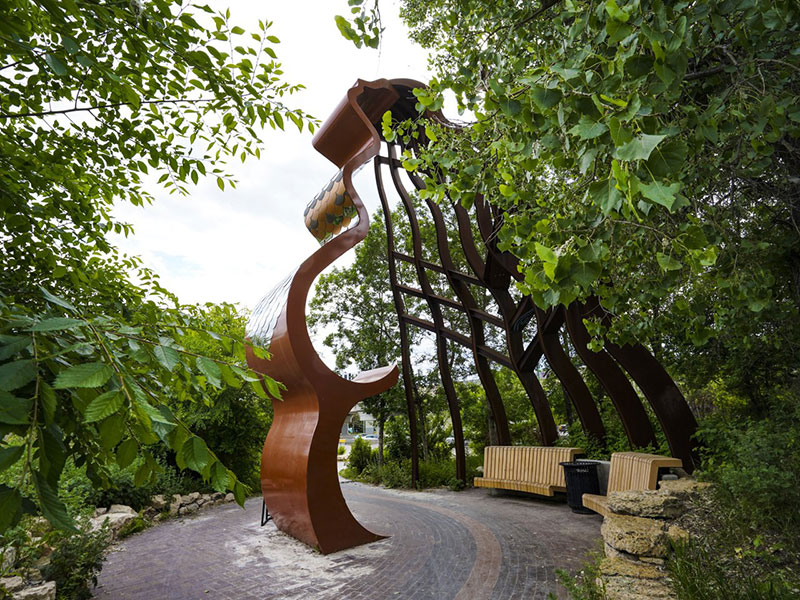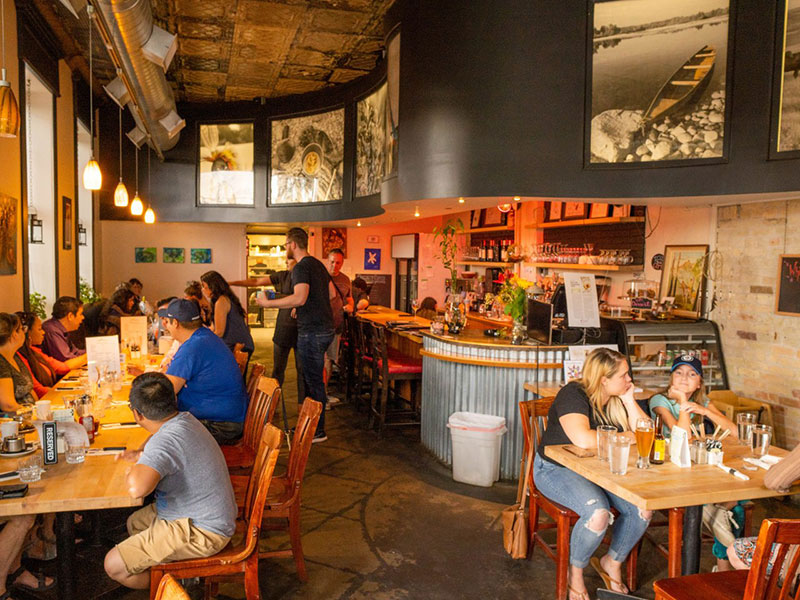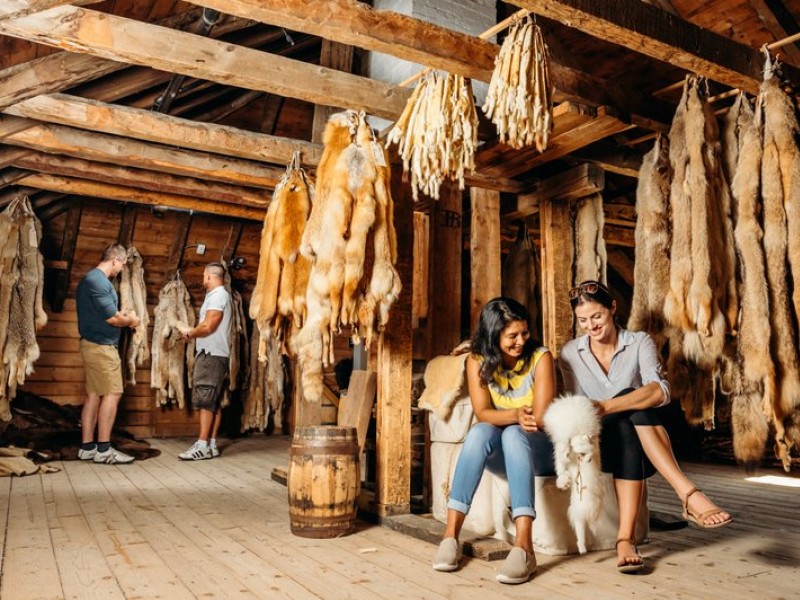
Oodena Celebration Circle
Find a spot on the grass of this natural shallow amphitheatre, which is also a popular gathering place for traditional tribal drumming, dancing, singing, and storytelling. Discover the circle’s sculptures, sundial, interpretive signage, and ceremonial fire pit which pays homage to the 6,000 years of Indigenous peoples in the area. When the sky is dark and the stars are out, stand at the base of the circle and look through the holes in the metal arms which, depending on the time of year, aligns with constellations such as the Big Dipper and Orion.
Visit Website
Louis Riel gravesite and Riel House National Historic Site
In the heart of Winnipeg’s French Quarter is the gravesite of Métis leader Louis Riel, the founder of Manitoba. Visit his final resting place at Saint-Boniface Cathedral Cemetery, Western Canada’s oldest Catholic cemetery. From there, head to Riel House, the site where the Metis leader’s body lay in state after being hung for treason in 1885. Here, interpreters explain what life was like for the Métis during and after the Red River Rebellion that Riel led.
Visit Website
Visual arts
Winnipeg Art Gallery-Qaumajuq is home to the world’s largest collection of contemporary Inuit art, along with a vast collection of Indigenous works in a variety of mediums. Qaumajuq, the $65-million Inuit art centre, opened in 2021 and has since been celebrated by countless publications—including the New York Times and Smithsonian—for its architecture, mandate and curatorial processes. Its opening exhibit, INUA, was curated by an all-Inuit team and features more than 100 works by 90 artists from across the Arctic. The exhibit covers old, modern and contemporary works in mediums as varied as paintings, tapestries, sculpture and even a seal skin spacesuit (by artist Jesse Tunjilik). Qaumajuq’s foyer houses a massive three-storey glass vault showcasing 5,000 carvings from more than 32 Northern communities. In the Exchange District, the Urban Shaman Contemporary Aboriginal Art Gallery is one of the foremost venues and voices for Indigenous art in Canada, while Canadian Plains Gallery Inc is a hidden gem featuring works from Cree, Michif, Ojibwe, Dene, Inuktitut, Dakota and Ojibwe-Cree artists in several mediums.

Manitoba Museum
The Manitoba Museum’s Indigenous Advisory Circle features members, academics and artists from the Dakota, Denesouline and Anishinaabekwe First Nations, along with Inuit elders and members of the Métis Nation. This Circle has been instrumental in bringing the Museum’s exhibits into the 21st Century, guiding aspects like Treaty Interpretation, Truth and Reconciliation and the handling and display of important artifacts. To learn more of the area’s Indigenous history, you’ll find content in nearly every gallery, while notable exhibits include, We Are All Treaty People, the newly expanded and re-designed Prairies Gallery (which confronts Residential Schools and historic injustices on the land) and the iconic Welcome Gallery, which features a life-sized diorama of a Métis bison hunt.
Visit Website
Niizhoziibean - The Gathering Place at The Forks
In the past few years The Forks has created, to quote national award-winning columnist Niigaan Sinclair, “one of the largest collections of Indigenous-led public expressions in any historical site in Canada.” Sinclair is the Indigenous Curator of The Forks National Historic Site and the host of The Forks’ Self-Guided Audio Tour, which covers aspects of the site’s 6,000-year history while guiding you to its public works of art. He was also instrumental in the creation of Niizhoziibean, the newest addition to the site that celebrates its Indigenous history while providing a gathering place for future generations. Here you’ll find works of art like Niimaamaa (“my mother’)—a huge sculpture by KC Adams, Jaimie Isaac and Val Vint—a new wigwam created for ceremony, gardens brimming with medicinal plants, and signage throughout the area in Cree, Ojibway and Michif.
Visit Website
Feast Café Bistro
Feast’s owner Christa Bruneau-Guenther is a member of the Peguis First Nation, an advocate for Indigenous cuisine and a nationally recognized culinary celebrity—being part of the judging panel on Food Network Canada’s Wall of Chefs. She’s been profiled in nearly every Canadian publication you can name for her advocacy (Feast often trains young Indigenous staff with no prior experience), while her restaurant in the West End is the go-to spot for modern First Nation cuisine on the prairies, featuring dishes like tipi tacos, bannock pizzas and bison chili.
Visit Website
Indigenous Peoples Garden at the Leaf
The Indigenous Peoples Garden is a gathering place that celebrates Indigenous cultures and their deep philosophical understanding and respect for nature. Elders and community members came together to work with two local Indigenous designers to create this space at Winnipeg's newest high-profile attraction. Indigenous youth helped in the garden's construction-from planting trees to building the boardwalk-while the plants species throughout the expansive grounds include local prairie grasses and perennials. Two elements, fire and water are feature prominently in the garden due to their importance in Indigenous cultures.
Visit Website
Manito Ahbee Festival
“Ignite your spirit” at this four-day celebration of Indigenous culture at Red River Exhibition Park (May 17-20, 2024). Witness (or join!) more than 800 dancers competing in the Manito Ahbee Pow Wow. Tap your toes as the fiddle plays for the Red River Jig and square dance exhibitions (you won’t believe how fast these feet fly!). Shop from makers from across Turtle Island at the Indigenous Marketplace and cap the experience off with the high-energy Indigenous Music Awards.
Visit Website
Winnipeg Aboriginal Film Festival
2024 Dates TBD
Fall in love with the colourful, striking and raw storytelling of leading Indigenous filmmakers at this three-day festival. Settle in for feature-length films, collections of shorts and thought-provoking documentaries. You might also find your new favourite director, as the festival often gives young Indigenous filmmakers their first break into mainstream media.

Lower Fort Garry National Historic Site
Stand where Treaty No. 1 was signed by the seven chiefs of the Ojibwe and Swampy Cree First Nations, creating the foundation of modern Manitoba. Run your hand along a historically accurate York boat and imagine what it was like to travel from Hudson’s Bay to this Red River settlement, which is still ringed by its circa-1830 stone walls. Learn about the Indigenous communities in the surrounding area and explore the grounds, which now includes a bison hide teepee and wigwam made by local Indigenous builders.
Visit Website
